Features
Forgotten protests in L.A.’s fight for LGBTQ+ rights in the U. S.
Every social movement has its origins in the resistance that arises from domination & the search for identity
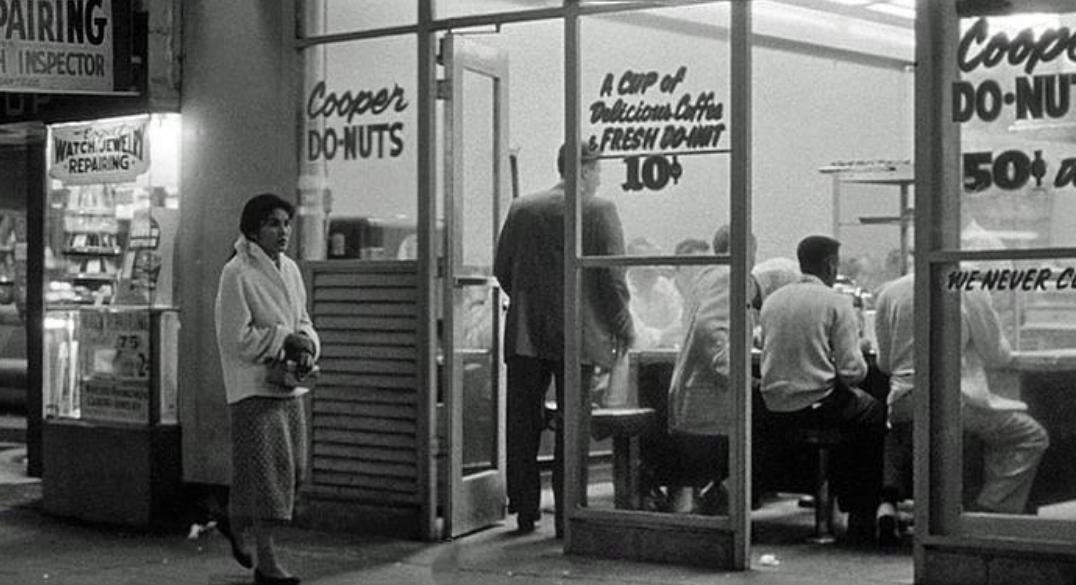
By Rodrigo Herrera | LOS ANGELES – On the opposite side of the country, two protests that preceded the Stonewall riots frame the legacy of history in the fight for LGBTIQ+ civil rights. The older – and nearly forgotten – one was the first time that Black and Latinx transgender individuals, their peers, and the long-forming community stood up against police brutality.
It is all too common that those responsible for documenting history often overlook the contributions of the most marginalized individuals, as well as the contextual factors that give rise to the social movements they inspire. This has motivated me to search for stories, characters, and sites historically relevant to the trans memory of LGBTIQ+ history, from Buenos Aires to Mexico City, and now Los Angeles.
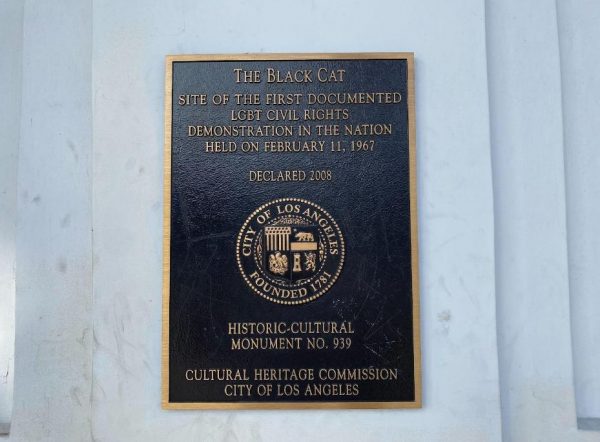
(Photo Credit: Rodrigo Herrera)
Although the first documented LGBTIQ+ civil rights demonstration in the United States occurred in 1967 in response to the Black Cat Tavern raid (1966), Pride commemoration today looks to the Stonewall Riots of 1969 as the event that catapulted the modern LGBTIQ+ civil rights movement.
A decade before those riots, in 1959, a Cooper’s Donuts coffee shop chain located on Main Street Downtown witnessed a clash between police and trans and queer people resisting arrest one early May morning. The coffee shop’s clientele, a diverse group of trans people, drag queens, and hustlers, rallied to their defense by throwing coffee and donuts, thwarting the arrest and forcing officers to retreat and call for backup. The incident caused the closure of the main avenue until the next day and has been documented by a witness, John Rechy, a Mexican-American writer, in his novel City of Night, published a few years later in 1963. This novel would present for the first time the Los Angeles queer scene. The transgressive novel would also inspire the lyrics of the song L.A. Women by The Doors, which describes the atmosphere of glamour, partying, and violence in the city.
The coffee shop episode is described in detail from Rechy’s testimony in the documentary book Gay L.A. A History of Sexual Outlaws, Power Politics and Lipstick Lesbians by Lilian Faderman and Stuart Timmons, was published in 2006.
It happened in the spring of 1959 at Cooper’s Donuts, a downtown coffee shop on a seedy stretch of Main Street between two of L.A.’s older gay bars, the Waldorf and Harold’s. Since their glamour days as early as the 1930s, both bars had grown shabby, but they offered refugee to the outcasts of that depressed enclave, who also made Cooper’s Doughnuts their hangout. Cooper’s was an all-night haunt, a place to get cheap coffee and doughnuts, a good place to camp or cruise or converse. Most patrons were queens, butch hustlers, their friends, and their customers. Many were Latino or Black. The queens wore the half-drag of Capri pants and men’s shirts, which, they hoped, would enable them to escape arrest for “masquerading” as women (though they knotted their shirts at the midriff in the feminine style of the day). Because the patrons were obvious or suspected homosexuals, Cooper’s became a frequent target for the Los Angeles Police Department, which prided itself on being one of the most determined enemies of homosexuality in the nation.
In order to understand the causes that led to such mobilizations, it is important to remember that today’s LGBTQ+ experience, although still facing violations of rights, is far different from what it was over seven decades ago. Discriminatory practices by officers of the Los Angeles Police Department included arbitrary detentions, excessive use of force, and arrests of individuals whose gender expression did not align with their identification. Merely being gathered with other queer people or attending a bar during a raid was sufficient grounds for being detained and charged. Even serving queer individuals was considered a business risk due to the harassment and surveillance it attracted from the police. Both homosexuality and transvestism (referred to as masquerading) were illegal and punishable as perversions and social deviations.
That night in May, a patrol car circle the block a few times, parked, and two police officers entered Cooper’s, demanding to see identification from those seated at the long rectangular counter. As usual, the police stated no reasons for their harassment. “You, you and you –come with us”, and ordered the men into their squad car. But just as would happen a decade later and a continent away at the Stonewall Inn, that night in Los Angeles, the crowd rebelled. The arbitrary arm of the law had come down “one time too many”. Rechy says: “First people started throwing the doughnuts they were eating at the cops. Then, paper cups started flying… Then coffee-stirring sticks and other things started flying at them”.
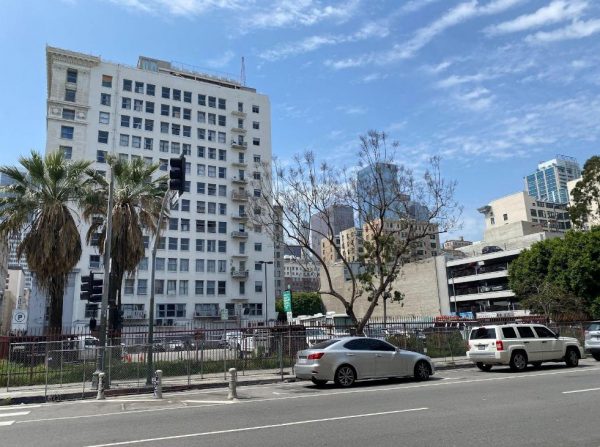
(Photo Credit: Rodrigo Herrera)
This could be considered the first uprising in LGBTIQ+ history, but the event has been poorly reported or documented.
The address 547 Main Street, corner of 6th, where the Cooper’s Donuts café used to be, is now a parking lot. Another address attributed to the space in other sources, 316 E 5th St, leads to San Julian Park, and the rest, extracted from the official website of the café chain—which is preserved online as a part of the memory of the uprising—lead to a small immigration office next to another parking lot across from the Cathedral of St. Vibiana, which has now been converted into a private event space.
The demolition of places like Cooper’s Donuts coffee shop has contributed to the amputation of trans history within the LGBTQ+ movement itself in the city, starting at nightclubs that more than mere bars, were considered institutions. However, a few places endure and although they have survived economic recessions, police brutality, and the AIDS pandemic, three years since the COVID-19 pandemic was declared, today they are at risk of disappearing along with most of the bars that served Latino and African-descent clientele in the city.

My third stop was what was considered the “gay ghetto.” Curious to discover what remained of “the run,” a corridor of meeting places for homosexuals along 5th Avenue and nearby bars that operated from the Prohibition era in the 1920s to the 1960s. I arrived at Pershing Square only to witness the transformation of the first and only public square that once served as a gathering place for the queer community in Los Angeles, who lived in anonymity and secrecy. It had now become a three-story parking lot topped with a thin layer of grass, statues, references, and figures with little context to each other, framed by the landscape of the financial district.
The “open-heart surgery” that meant the multiple redevelopments of Pershing Square since 1951 and the demolition of buildings with a strong historical burden for the LGBTQ+ community downtown is part of the suburbanization – and expulsion – machinery built for private cars over pedestrians, which ended up moving the “respectable citizens” to the suburbs and the queer scene to the west, in the city limits and on the margins of police repression.
The overwhelming presence of intoxicated homeless individuals and the marks of human waste on the concrete of Pershing Square contrast with the image of a father accompanying his daughter on the playground. This block has ceased to be a park, leaving behind the hustle and bustle and the vibrant nightlife it once had. Not even the strong police presence would make me want to return here at night. In reality, I had only a few hours left before sunset, and I still had to make my way to East Hollywood.
The next stop was The Black Cat. Located on Sunset Blvd, the building it occupies is now more Shake Shack than a tavern. There’s even a sonic battle between the two spaces, with pop music vs. lo-fi music competing within the modest Art Deco building. Built in 1939, it used to house a Safeway grocery store. By the 1960s, it had transformed into a gay bar and a laundromat that served a predominantly working-class clientele. The neighboring businesses were a series of establishments friendly to lesbian women and gay men.
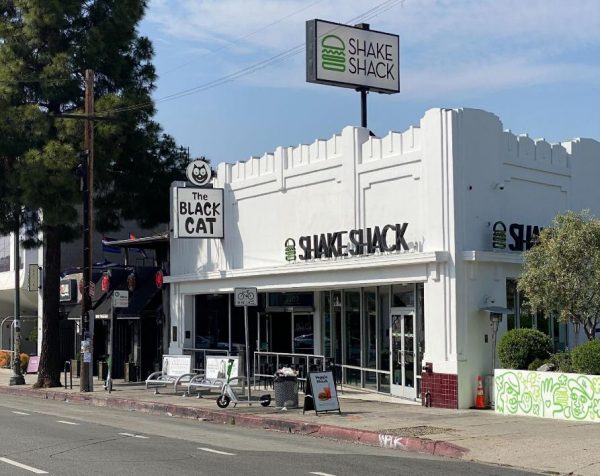
(Photo Credit: Rodrigo Herrera)
The Black Cat raid occurred at the moment when attendees were exchanging New Year’s Eve kisses and hugs. Eight undercover police officers (referred to as “Hollywood rejects” in the book Gay L.A. due to their attractiveness for deceiving gay men) conducted the raid at midnight. Fourteen people were arrested outside the bar and charged with assault and “public lewdness.” These arrests marked the first time that gay men were defended in a court case against a judicial system that disagreed with their lifestyle. In response, in February 1967, over 200 queer patrons of the tavern peacefully protested against police brutality following the raid. Some photographs of the protest can be seen on the walls along with paintings and artwork referencing cats. Outside, a plaque acknowledges the site as a cultural-historical monument. Perhaps it’s the morning’s disappointments, but I expected to find more substance, more photos, and more history of what transpired here.
Many significant sites for LGBTQ+ culture have been destroyed before their stories could be told or understood as part of the LGBTQ+ movement.
The LGBTQ+ Pride celebration in Los Angeles today commemorates the Stonewall riots in 1969, and while its significance has evolved to increasingly honor the contributions of Black and Latinx individuals who participated in this process (such as Marsha P Johnson and Sylvia Rivera), there is still much work to be done to do justice to their historical memory.
Every social movement has its origins in the resistance that arises from domination, the search for identity, and the desire to carve out a space in the world. Behind the vibrant LGBTQ+ scene we see in Los Angeles today, lies the history of trans individuals, which is an inseparable part of LGBTQ+ history. This history is often forgotten and stigmatized, even within the same community, but it refuses to be forgotten.
This research has been very frustrating, primarily due to the lack of records and documentation regarding the milestones in LGBTQ+ rights history. However, I decided to give it one last chance and visit the Central Library the next day to explore more sources and databases. Many people have come to the library asking about records of what happened at Cooper’s. The incident has even been endowed with myth, a category that lies between the unverifiable and the irrefutable.
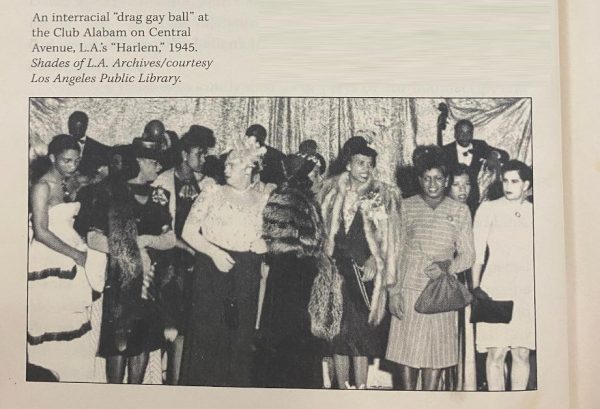
It wasn’t until I returned to the book “Gay L.A.” that I realized the true importance of Cooper’s Donuts. The event at the cafeteria, along with countless other reasons, inspired the documentation work for the book. The lack of records further fueled Faderman and Timmons’ search, and in the process of uncovering those stories, they interviewed around 300 people of different backgrounds, identities, and ages ranging from 16 to their 80s and beyond. It was thanks to the photographs and documents treasured by individuals and organizations that other historical milestones, dating even further back in time, were discovered, showcasing the fabric of our community and our collective struggle. For example, the documenting of an “interracial gala” that took place at the Club Alabama on Central Avenue, the “Harlem” of L.A., in 1945.
What makes a building or an event historically significant? Who decides? How do we tell the stories of people and places for which we have no remains? We demand too much from trans history. We ask for documentation, archives, and records, but for a long time, there was hardly any trace of their lives in history. They barely appeared in the media, and when they did, their lives were dehumanized and denigrated.
The revolution began almost a decade before Stonewall, in the heart of the world’s entertainment capital (or even earlier), and LGBTQ+ history must honor the memory and dignity of the trans and queer individuals who dared to throw the first stone (or donut) in defense of the dignity of all people.
****************************************************************************************
We are searching for memories and recollections about places of interest, historic locations, and beloved personalities that are part of our trans and queer memory in Los Angeles.
Queer Maps – An explorable archive built to preserve and share histories of LGBTQ+ spaces, organizations, etc. in Los Angeles from 1871 → today. (Link)
****************************************************************************************
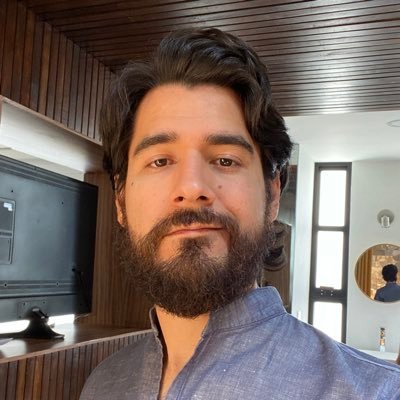
Rodrigo Herrera is the editor of The New Gay Times and a contributor to both the Washington Blade and Los Angeles Blade.
The New Gay Times is a Mexico City-based media outlet that publishes stories, news and literature for diversity. The space arises as a response to the low representation of more diverse content in the media.
****************************************************************************************
Sources:
Los Angeles Conservancy – The Black Cat
ONE Nation Gay & Lesbian Archives at the USC Libraries
- ONE Archives at the USC Libraries – The Black Cat
Ultimate Classic Rock – The stories behind the songs of The Doors’ last hurrah, ‘L.A. Woman’.
Gay L.A.: A History of Sexual Outlaws, Power Politics, and Lipstick Lesbians
Lillian Faderman and Stuart Timmons
LA Times (2021) – New Jalisco: más que un bar, un salvavidas para los latinos LGBTQ, ahora al borde del cierre
LA Times (2014) Op-Ed: Why we hate Pershing Square
BBC: El baile de los 41: la fiesta gay de la élite de México que desató un escándalo hace más de un siglo
Features
Los Angeles Blade kicks off Free Community Event Series with an informative political panel of government and advocacy group leaders
Time To Get Informed, Time To Resist will be hosted by The Abbey on Saturday, April 19th at 10 am, as an open forum to present the current political climate as it affects SoCal for the queer community and beyond.

Time To Get Informed, Time To Resist will be hosted by The Abbey on Saturday, April 19th at 10 a.m., as an open forum to present the current political climate as it affects SoCal for the LGBTQ community and beyond.
In its commitment to be a thriving resource for the SoCal community, the Los Angeles Blade, in partnership with Roar Resistance, will present its first free community event. The Time To Get Informed, Time To Resist panel will include government and advocacy group leaders who will discuss political news regarding the LGBTQ community and beyond, as it affects residents and business owners in California. The panel will also share different ways the community can activate and get involved. The event will conclude with a Q&A session.
The panel will be moderated by non-profit activist Michael Ferrera, representing Roar and will include Mayor of West Hollywood, Chelsea Byers; Jorge Reyes Salinas, Communications Director of Equality California; Abbe Land, former Mayor of West Hollywood and Co-Chair of Roar, Chris Baldwin; NAACP LGBTQ+ Committee Chair and Nico Brancolini, Political Vice President for Stonewall Democratic Club.
“We need to focus on the real issues to effectively resist. This forum will serve to educate concerned citizens and help them act locally to achieve this goal,” said Ferrera.
Join us for this free event on Saturday, April 19th at 10 am at The Abbey.
For more information, contact [email protected]
Features
Finding love in queer Los Angeles with matchmaker Daniel Cooley
Is it hard to date in queer Los Angeles? We do a deep dive into finding love with one of the community’s most in-demand matchmaker.
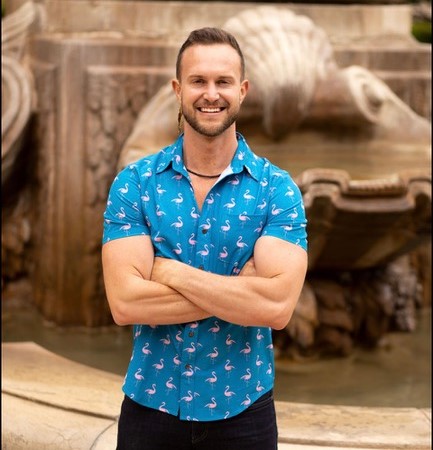
For those of us gay singles in Los Angeles, we know that dating can be difficult. In addition to all the usual dating issues, the queer community also has to deal with body issues, open relationships and hookup apps. Even with a large population of queer folk, trying to find love in Los Angeles can often seem futile. Is it possible to find love in today’s tech age?
Enter professional matchmaker Daniel Cooley, co-owner of Best Man Matchmaking, on a mission to help LGBTQ+ folks find real love and long-term commitment. You may have seen him see him pop up on TV, or may have heard about his packed singles mixers.
He and his full team (which even includes an astrologer and stylist) have a system that is tried and true. He is fully in tune with the challenges that queer singles face. We sat and chatted about it all—dating apps, monogamy, red flags, first dates, and more!
How did you get into the world of matchmaking?
A decade ago I appeared on the reality show “Millionaire Matchmaker” as a match for underwear designer Andrew Christian. I remember looking up to Patti Stanger’s ability to help singles understand the reasons why they might be single—she was so fierce and fabulous. Around that same time, I had also started a nonprofit focused on HIV-related needs. Within that non-profit, I helped build a large social network and club—made up mostly of gay, bi, or queer men. People would constantly ask me if I knew anyone in the group who was single.
I became known as the “divine connector,” always linking people to opportunities—whether it was a job, a new friend, or a date. I curated tons of long-term relationships, marriages, and lasting friendships. Years later, when I began to sell real estate, my single clients would often ask if I knew anyone they could potentially share their new home with.
That’s when I reached out to the only gay matchmaker I knew at the time, Mason Glenn, who used to run The Gay Matchmaking Club in Los Angeles. He introduced me to Anthony Canapi, who was working for a local matchmaker and eventually founded “Best Man Matchmaking”—working with him as a recruiter and matchmaker. Now I am the co-owner and CEO of “Best
Man Matchmaking.”
In your opinion, what are the biggest challenges today in dating in the LA
queer community?
One of the biggest challenges with dating in the queer community is that many people haven’t done the inner work. Instead of connecting over shared morals, values, interests, and genuine connection, a lot of guys—especially those struggling with low self-esteem—are constantly chasing the next best or hottest thing.
I can’t tell you how many times I’ve tried to help men be more realistic with their expectations, but the response is often, “Well, he hooked up with me on Grindr, so why wouldn’t he date me?” The truth is, just because someone hooks up with you doesn’t mean they want to build a relationship with you. Swipe culture, hookup apps and social media have made dating more difficult—not just in the queer community, but across the board. Add to that
the trauma and insecurities many gay men are still working through, and it becomes even harder. Rejection from society is one thing, but rejection from within our own LGBTQ community—whether in dating or just trying to make friends—can be deeply painful. I hear horror stories all the time from gay men who feel consistently shut out by the very people they’re trying to connect with.
At what point should people turn to matchmaking to find a possible match?
There’s really no right or wrong time to turn to a matchmaker—but we recommend you begin the process before you think you’re ready. Some men wait until they are completely frustrated and exhausted dating on their own and that’s usually too late. You want fresh eyes and an open heart getting the process started with your matchmaker, not a jaded outlook.
Most of the clients we represent hire us because they value privacy and have a clear idea
of who they seem themselves with, coupled with the ongoing inner work of understanding what they have to offer their partner. And I’m not talking about physically or financially – the clients we place in relationships the fastest are the ones who know themselves really well. Did you know that recent studies show people are spending an average of 27 to 45 hours a month on dating apps? That seems unhealthy to me.
I love when my clients tell me that working with us feels like meeting someone “the organic way.” Like they are being introduced to a great match through a trusted friend. Hiring a matchmaker is like having a close friend who knows you really well and has access to a network of high-quality, relationship minded men. It’s that simple.
What are the biggest factors that you consider in matching people up?
Our matchmaking is based on 4 core concepts:
Morals & Values:
We look at core beliefs—how someone lives their life, what they stand for, and how they treat others. Shared values create long-term compatibility.
Interests & Lifestyle:
Do they enjoy the same things? Travel style, social life, routines—these everyday details matter when building a life together.
Sexual Compatibility:
This is especially important for gay men. Desire, preferences, and position in the bedroom. You can’t leave this out because it can make or break a connection.
Relationship Intentions:
We match people based on where they are emotionally and what kind of
relationship they’re ready for—not just who they’re attracted to.
What are some red flags that someone should never ignore?
There are two main red flags we screen for in matching our clients. Unclear communication is a major red flag. It’s one thing to be busy, but if they’re taking days to reply or you’re always the one initiating plans, that shows a lack of effort. Don’t expect that to magically change—poor communication doesn’t improve unless the person is actively working on it.
If someone says they are not sure what they want out of a relationship or connection, this is another red flag for us. For example, if they say they’re open to a relationship “if it happens,” but aren’t clear about wanting something long-term—believe them. Take their words seriously and move on. It’s better to invest your time in someone who knows what they’re looking for.
In your opinion, what would be a good first date?
A great first date involves doing something you genuinely enjoy—whether it’s trying out a new restaurant, hiking a trail you’ve been meaning to explore, or visiting a museum you’ve had your eye on. If your date enjoys it with you, there’s a good chance you’ll naturally connect. We’ll curate a first date for our clients that reflects their lifestyle, hobbies, and life stage.
What are the biggest mistakes people make when going on a date?
There’s one that we look out for.
The biggest mistake is not staying present. People often talk too much about themselves out of nervousness, instead of asking questions and getting to know their date. A common slip-up is bringing up an ex or sharing recent drama in their life. Leave the drama at the door and focus on enjoying the person in front of you.
It seems that monogamy has become less popular in relationships. Is this
true?
Monogamy is still very popular. Over 80% of the people who reach out to us are looking for a monogamous relationship. The rest may be open to something more flexible, like “monoga-mish”—meaning they’re in a committed relationship but open to exploring non-monogamy down the line—or they’re simply open-minded about different dynamics.
Our clients are men who are looking for the same kind of companionship many people want: a long-lasting relationship, emotional connection, and a true partner to build a life with.
Can open relationships work?
Absolutely! The one thing that’s absolutely necessary for any relationship to work— trust. The only way to build trust is to communicate your needs clearly.
If you’re in an open relationship and you’re sneaking around sleeping with everyone without being honest with your partner, chances are it’ll never work out. But if you’re transparent, if you let your partner know you love them and your needs also include connection with others—and they’re comfortable with that—then there’s no reason it can’t work.
We know the world of apps has changed the dating scene. Is it possible to
meet a quality date from an app?
Definitely.. But unfortunately, it’s more a matter of luck and timing to meet someone who’s actually relationship-ready, emotionally stable, financially secure, and checks most of your boxes.
You can meet your match anywhere! We encourage our clients not to put all their eggs in one basket. Many leave the apps on their own because they’re tired of wasting time with people who aren’t as serious about dating as they are. But others see the value in putting themselves out there in lots of different ways and love having our support while swiping.
What’s the best piece of advice you can give single people who are looking
for a relationship in Los Angeles?
People are craving touch, connection, and love. Try approaching more people you find attractive in real life—whether it’s at the store, the gym, or a social event. Be bold and courageous—people find that attractive. It’s easy to get rejected online, but most people are tired of the apps and are ready for something more real.
This might be an unpopular opinion, but I’ve found that people in LA can be flaky and passive-aggressive.
I say: be direct. Let people know what you want. If it’s not a match, just be honest and let them know. Don’t lead them on, or ghost them.
What do you love most about matchmaking?
Matchmaking is both the most rewarding job I’ve ever had and the most challenging. My favorite part of being a matchmaker is when a client is genuinely excited and hopeful about someone they just met through us. It happens everyday. There’s nothing more rewarding than supporting someone get closer to finding the person they want to spend their life with. It’s priceless and makes all the hard work worth it.
What have been the biggest things you’ve learned in matchmaking?
Being selective about emotional compatibility and shared values is healthy and critical if you’re serious about meeting someone—but being overly picky about things like looks or having the “perfect body” doesn’t serve anyone long-term.
What is your message to the single queer community of Los Angeles?
Do the inner work. Ask yourself if you’re truly being the person you want to date. If not, what unhealed emotions or past experiences are holding you back? The moment you begin that work, you open yourself up to deeper, more meaningful connections.
Stay tuned for Daniel’s new love and dating Los Angeles Blade column, coming soon!
For more information, check out BestManMatchmaking.com
Features
Tristan Schukraft speaks on keeping queer spaces thriving
The new owner of the Abbey continues to expand to protect queer spaces

Like the chatter about Willy Wonka and his Chocolate Factory, the WeHo community started to whisper about the man who was going to be taking over the world-famous Abbey, a landmark and part of history in Los Angeles’ queer nightlife. Rumors were put to rest when it was announced that entrepreneur Tristan Schukraft would be taking over the legacy created by Abbey founder David Cooley. All eyes are on him.
For those of us who were there for the re-opening of The Abbey, when the torch was officially passed, all qualms about the new regime went away as it was clear the club was in good hands and that the spirit behind the Abbey would forge on. Cher, Ricky Martin, Bianca del Rio, Jean Smart, and many other celebrities rubbed shoulders with veteran patrons, and the evening was magical and a throwback to the nightclub atmosphere pre-COVID.
The much-talked-about purchase of the Abbey was just the beginning for Schukraft. It was also announced that this business impresario was set to purchase the commercial district of Fire Island, as well as projects launching in Mexico and Puerto Rico. What was he up to? Tristan sat down with us to chat about it all.
“We’re at a time right now when the last generation of LGBT entrepreneurs and founders are all in their sixties and they’re retiring. And if somebody doesn’t come in and buy these places, we’re going to lose our queer spaces.”
Tristan wasn’t looking for more projects, but he recounts what happened in Puerto Rico. The Atlantic Beach Hotel was the gay destination spot and the place to party on Sundays, facing the gay beach. A new owner came in and made it a straight hotel, effectively taking away a place of fellowship and history for the queer community. Thankfully, the property is gay again, now branded as the Tryst and part of Schukraft’s portfolio with locations in Puerto Vallarta and Fire Island.
“If that happens with the Abbey and West Hollywood, it’s like Bloomingdale’s in a mall. It’s kind of like a domino effect. So that’s really what it is all about for me at this point. It has become a passion project, and I think now more than ever, it’s really important.”
Tristan is fortifying spaces for the queer community at a time when the current administration is trying to silence the LGBTQ+ community. The timing is not lost on him.
“I thought my mission was important before, and in the last couple of months, it’s become even more important. I don’t know why there’s this effort to erase us from public life, but we’ve always been here. We’re going to continue to be here, and it brings even more energy and motivation for me to make sure the spaces that I have now and even additional venues are protected going in the future.”
The gay community is not always welcoming to fresh faces and new ideas. Schukraft’s takeover of the Abbey and Fire Island has not come without criticism. Who is this man, and how dare he create a monopoly? As Schukraft knows, there will always be mean girls ready to talk. In his eyes, if someone can come in and preserve and advance spaces for the queer community, why would we oppose that?
“I think the community should be really appreciative. We, as a community, now, more than ever, should stand together in solidarity and not pick each other apart.”
As far as the Abbey is concerned, Schukraft is excited about the changes to come. Being a perfectionist, he wants everything to be aligned, clean, and streamlined. There will be changes made to the DJ and dance booth, making way for a long list of celebrity pop-ups and performances. But his promise to the community is that it will continue to be the place to be, a place for the community to come together, for at least another 33 years.
“We’re going to build on the Abbey’s rich heritage as not only a place to go at night and party but a place to go in the afternoon and have lunch. That’s what David Cooley did that no others did before, is he brought the gay bar outside, and I love that.”
Even with talk of a possible decline in West Hollywood’s nightlife, Schukraft maintains that though the industry may have its challenges, especially since COVID, the Abbey and nightlife will continue to thrive and grow.
“I’m really encouraged by all the new ownership in [nightlife] because we need another generation to continue on. I’d be more concerned if everybody was still in their sixties and not letting go.”
In his opinion, apps like Grindr have not killed nightlife.
“Sometimes you like to order out, and sometimes you like to go out, and sometimes you like to order in, right? There’s nothing that really replaces that real human interaction, and more importantly, as we know, a lot of times our family is our friends, they’re our adopted family.
Sometimes you meet them online, but you really meet them going out to bars and meeting like-minded people. At the Abbey, every now and then, there’s that person who’s kind of building up that courage to go inside and has no wingman, doesn’t have any gay friends. So it’s really important that these spaces are fun, to eat, drink, and party. But they’re really important for the next generation to find their true identity and their new family.”
There has also been criticism that West Hollywood has become elitist and not accessible to everyone in the community. Schukraft believes otherwise. West Hollywood is a varied part of queer nightlife as a whole.
“West Hollywood used to be the only gay neighborhood, and now you’ve got Silver Lake and you’ve got parts of Downtown, which is really good because L.A., is a huge place. It’s nice to have different neighborhoods, and each offers its own flavor and personality.”
Staunch in his belief in his many projects, he is not afraid to talk about hot topics in the community, especially as they pertain to the Abbey. As anyone who goes to the Abbey on a busy night can attest to, the crowd is very diverse and inclusive. Some in the community have started to complain that gay bars are no longer for the gay community, but are succumbing to our straight visitors.
Schukraft explains:
“We’re a victim of our own success. I think it’s great that we don’t need to hide in the dark shadows or in a hole-in-the-wall gay bar. I’m happy about the acceptance. I started Tryst Hotels, which is the first gay hotel. We’re not hetero-friendly, we’re not gay-friendly. We’re a gay hotel and everyone is welcome. I think as long as we don’t change our behavior or the environment in general at the Abbey, and if you want to party with us, the more than merrier.”
Schukraft’s message to the community?
“These are kind of dangerous times, right? The rights that we fought for are being taken away and are being challenged. We’re trying to be erased from public life. There could be mean girls, but we, as a community, need to stick together and unite, and make sure those protections and our identity aren’t erased. And even though you’re having a drink at a gay bar, and it seems insignificant, you’re supporting gay businesses and places for the next generation.”
Features
Drag Race’s Honey Davenport New Fashion Line Is Making A Statement
Introducing Honey’s Hose: The World’s FIRST Drag and Black Queer Owned Inclusive Hosiery Brand by RuPaul’s Drag Race Legend Honey Davenport
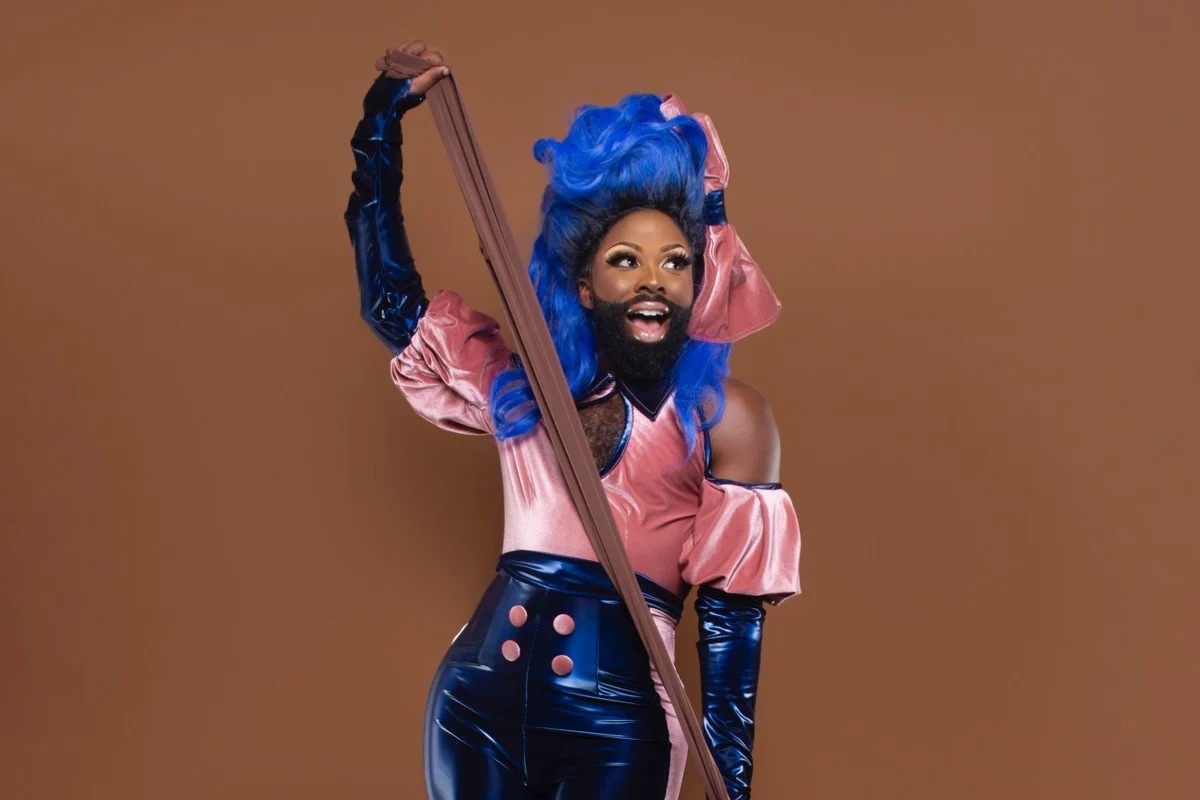
Powerhouse drag performer, musician, DJ, activist and Drag Race alum Honey Davenport can now add entrepreneur to her long list of titles. A proud member of the leather community and fierce advocate for the LGBTQ+ and BIPOC communities is combining art, sensuality and fashion with her debut business — Honey’s Hose.
Developed alongside her best friend Saul Williamson, Honey’s Hose offers a wide variety of high-quality hosiery specifically designed for all skin tones, body sizes and budgets. Their mission is to empower individuals through style, comfort and confidence, celebrating self-expression.
Honey’s Hose will also establish the Honey’s Heaux Artist Fund to help emerging drag artists, enabling them to access the perfect hosiery for their performances.
After spending time crowdfunding, attending business seminars and accelerator programs, the line officially launched this weekend with a huge drag queen bash in Palm Springs. We caught up with Honey in between celebrating to talk about her new venture, the power of sexuality, supporting the Black and drag communities and what the future has in store.
Why has it taken so long to get drag queens and diverse body sizes represented in the hosiery industry?
Honestly, it’s baffling. For decades, the hosiery industry has clung to a very narrow, outdated ideal of beauty. It’s a reflection of a larger societal problem – the constant marginalization of anyone who doesn’t fit the ‘norm.’ Drag queens, with their vibrant artistry and fearless self-expression, have always been at the forefront of challenging those norms. Bodies of all shapes and sizes deserve to be celebrated, not ignored. It’s about time the hosiery industry caught up with reality and recognized the beauty and power in our diversity. It’s not just about selling hose, it’s also about acknowledging and celebrating who we are.
Every day there seems to be more and more attacks on the queer and drag community. As a queer, Black business owner, how do you think we are going to get through these next few political years?
It’s terrifying. It’s exhausting. But, as a queer, Black business owner, I refuse to be silenced. Our strength lies in our community. We have to support each other, amplify each other’s voices and never stop fighting for our rights. We’ve faced adversity before and we’ll face it again. Resilience, creativity and unwavering love for who we are – that’s how we’ll get through this.
We have to continue to create visibility, celebrate our joy and show the world that we will not be erased. We will continue to build our chosen families and create safe spaces for our community.
How can we best support the drag community?
Show up!
Go to the shows, tip the queens and celebrate their artistry. Beyond that, support businesses that are vocal allies. Speak out against hate and discrimination. Educate yourself and others about the history and importance of drag. Most importantly, listen to the drag community. They know what they need and they deserve our respect and support.
How can the queer community best support the Black community?
Listen. Learn. Amplify. Educate yourself about the unique challenges faced by Black queer individuals. Support Black-owned businesses, including Black queer businesses. Show up for Black, queer events and other movements fighting for racial justice. Call out racism within the queer community. Remember that solidarity isn’t just a word, it’s a commitment to action.
What have been some of the biggest challenges in creating Honey’s Hose?
Where do I start? Sourcing inclusive sizing has been a huge hurdle. Manufacturers just weren’t equipped to handle the range we needed. Finding the right colors to truly represent diverse skin tones has been another challenge. And of course, navigating the business world as a queer, Black entrepreneur has its own set of obstacles. But every challenge has been worth it. Seeing the joy on someone’s face when they finally find hose that fit and celebrate their skin tone – that’s what keeps me going.
Do you come from a fashion design background, what was the creative process in putting the line together?
My background is actually in musical theatre and I have mostly just excelled at being fabulous, though I’ve always had a passion for self-expression through fashion. Creating Honey’s Hose, was a process of listening to the community, identifying their needs and then working with talented mentors, collaborators and manufacturers to bring my vision to life. It was a life-changing effort, fueled by passion and a deep desire to create something truly special.
Besides representing all body types, what sets Honey’s Hose apart from other hosiery lines?
It’s more than just hose — it’s a statement. It’s about celebrating individuality, embracing our bodies and expressing ourselves without limits. We’re committed to quality, comfort and inclusivity in every aspect of our business. And we’re not just selling a product — we’re building a community. Honey’s Hose is about feeling confident, powerful and seen.
What do you love most about being a business owner?
The ability to create something meaningful. To build a brand that celebrates diversity and empowers people to feel good about themselves and create opportunities for others in my community.
What did you have to learn quickly about owning your own fashion line?
Everything! [But] never at the pace I expected. Seriously, it’s a crash course in business, design, manufacturing, marketing… I’ve learned to be resourceful and resilient and to ask for help when I need it. I’ve learned that passion and perseverance are essential ingredients for success.
Along with body diversity, you use your platform to promote sexuality. Why is it so important for queer people to continue talking about sex?
Because our sexuality is a part of who we are. It’s not something to be ashamed of or hidden away. By talking openly and honestly about sex, we destigmatize it, we empower ourselves, and we create a space for healthy conversations about pleasure, consent, and identity. Especially now, with so many attacks on our rights, it’s crucial that we continue to celebrate our bodies and our desires.
What are some basic hosiery pieces every queen should have in her closet?
A good pair of fishnets, of course! They’re a classic for a reason (and I do personally hope to one day create the best pair). Some bold, colorful tights to add a pop to any outfit and some comfortable, durable support hose for those long nights on stage.
Are we going to see more fashion designs from you in the near future?
Absolutely! Honey’s Hose is just the beginning. I have so many ideas and visions for the future. Stay tuned!
a&e features
David Archuleta celebrates his freedom
The American Idol alum channels George Michael with his latest single
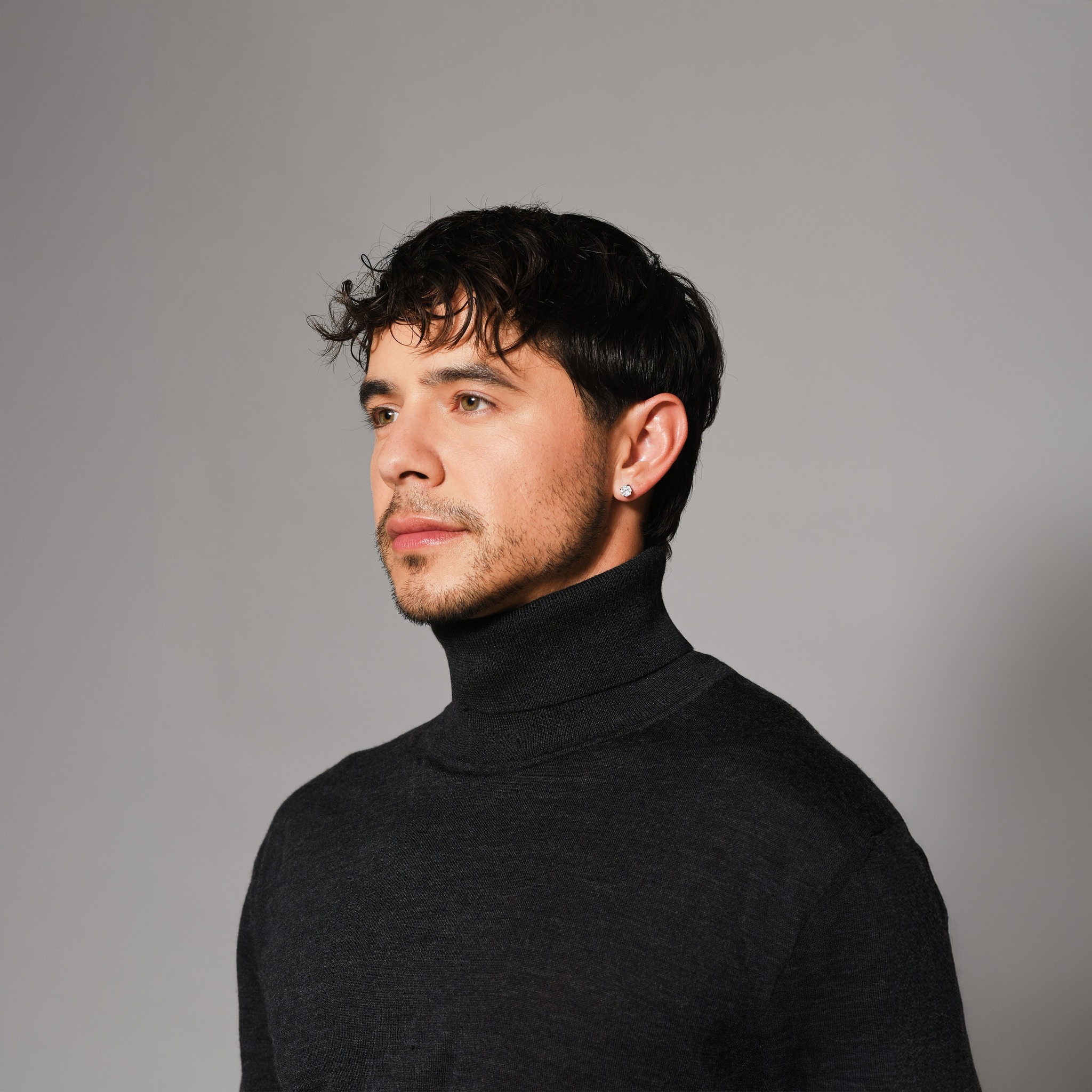
Even the rain couldn’t keep the crowds away as American Idol alum David Archuleta took the stage at The Abbey in West Hollywood, celebrating the release of his latest single “Freedom,” – an homage to George Michael’s iconic anthem. “Freedom” comes on the heels of the 35th anniversary of the original anthem and it couldn’t be more timely as the LGBTQ+ community continues to face political persecution. The song celebrates Archuleta’s newfound freedom after coming out and dealing with a complicated relationship with his Mormon upbringing, while exploring his sexuality.
Archuleta happens to have been born the year Michael released “Freedom.” His music served as an inspiration in Archuleta’s coming out. Michael’s music took on new meaning for Archuleta, celebrating a freedom that he craved for himself growing up. Being able to pay homage to Michael is a testament to the personal growth Archuleta experienced since coming out in an Instagram post in 2021.
“I’m finally free from worrying about what is right. Does that look okay? Am I within the lines I’m supposed to? None of that really matters. Of course, we want to still be good, but the things I thought I needed to do, or the way I had to behave or act or say or think to be good, I now realize was a construct that someone else had. They were very black and white and the community that I was in created this safe little space that worked to an extent for certain people,” said Archuleta in an interview with LA Blade.
“Now I realize that they didn’t have all the answers that they told me and convinced me that they had. Sexuality, especially when it comes to queerness, is not what they thought it was. I can go ahead and live my own life now and it’s okay to explore that sexuality and sensuality. I’m an adult. It’s the freedom to explore yourself and also create a new identity in yourself after trying to live someone else’s idea of what you’re supposed to be your whole life up until your thirties.”
Archuleta’s vocals are soulful and mature here. He pays homage to the original, but also makes it his own.
“I thought it was a great message to tap into. It is an iconic song with an iconic video and quite the story that he had. He was a pop star, a heartthrob, and didn’t choose to come out. He got outed and he just owned it. There could have been a lot of other ways to go about that and I feel like the way he did it was so powerful and made him even more legendary because he really tapped into his sensuality and continued to consistently be one of the greatest pop stars in the world,” said Archuleta.
“I tried to stay pretty true to his version. At first, we actually made a dance version of it but decided to backtrack from it and say, you know what? This is George’s legacy and it’d probably just be better to just stay true to his energy that he put into it. And also stay more true to my energy. I decided to stay true to an MTV unplugged version that he did with a choir. I have gospel roots. I still love gospel music even though I don’t believe in it and what it’s saying and the messaging like I did before,” he reflected.
“It used to be everything for me, the performance in the emotion and the way you connect in your core to singing. I thought it was a beautiful way to combine my two passions of moving forward and being free, but also loving the soul in music. I felt like there was some great soul energy in there. I was able to get really gritty, even get a lot of growling, something I haven’t done for quite a while, I feel like in my music,” he said.
“Freedom” comes at a time when every day LGBTQ rights are being called into question. The timing is not lost on Archuleta.
“I think it’s unfortunate that the LGBTQ+ community always has to be targeted because of being a smaller group. Living our lives does not really enter fear with anyone else. But because fear-mongering works in the news, it works in politics, it works in rallying people behind someone to feel like they have to fight this cause. They are blaming the community for issues and fear-mongering and feeling like the queer community’s a threat to families and to religion. When a lot in the queer community are religious. They are actively participating and fully believing and are a part of families. They have children of their own. It’s just strange that politics click baits and instills fear to not take responsibility for the real issues that are actually impacting people. We were making great progress. It was so much easier for me to come out when I did versus when George Michael came out and now it’s back to a place where the fearmongering is getting people, especially the trans community.”
Archuleta’s personal journey continues to evolve. He has certainly thrown off the shackles of being branded as the innocent Mormon kind on American Idol.
“I don’t really know what my brand is anymore. I think as I release “Freedom,” it’s kind of like a rebranding. I’m still me, but I’m still also evolving. I feel like I’ve changed so much in the last two years. I’m having a fun time. I keep trying to push my boundaries and say yes to things that I wouldn’t have before. Even to the point where I’m writing songs and writers will be like, “David Archuleta can’t say that!” I’m like, well, I just did and I’m David Archuleta. But people sometimes feel weird and I guess it’s because I’ve always been squeaky clean. I’m not a Mormon anymore. I’m out and I don’t really have this religious ideology that I have to abide by. I am David, but I don’t have the same limits on me that I had before.”
Archuleta has more new music on the way and this summer, he will release his memoir. Writing his book was bittersweet for David, revisiting his past came with a few bumps along the way.
“I feel like it was traumatic. I had to take breaks. It’s like opening Pandora’s box going into your childhood because I feel like sometimes I’m too honest. You see some of the faulty programming that you still have wired in you and you kind of question like, why am I still abiding by that? If it happened so long ago, why am I still letting it affect me? Why is it still part of my belief? I’ve had to work through a lot and it’s been a more difficult process than I thought it would,” he said.
“I thought it’d be hard to write because I didn’t know what I was going to talk about. But that wasn’t the hard part. What’s hard is processing the emotions, the anger, the grief, the anxiety, the traumatic responses you have. But it’s been good. I’ve definitely processed a lot of my religious things. I’ve processed a lot of my internalized homophobia and just sexuality in general. It’s been interesting to reflect on the root of all of those things. And not just ideologies, but just realizing it’s not just a belief, it’s sometimes your genetics that make you the person you are. A lot of good self-reflection for sure,” he continued.
Archuleta’s fanbase continues to thrive along with each evolution the singer has gone through. He is grateful for his fans and his mission to remain true to himself is also for his fans. There is sincerity and truth at the heart of his music.
“To my fans, thank you for being here still and for enjoying what I’m doing, for cheering me on as I grow, as I fumble. I didn’t think fumbling and making mistakes was okay to do. I thought that for some reason if you make mistakes, you’re supposed to be unforgivable. And to see how forgiving of a following I have to let me learn and to experiment and to explore. That’s why I relate to George Michael’s “Freedom” because he had to explore in front of people. And of course, you want to keep parts of your life private, that’s what I prefer. But sometimes things just end up being people’s knowledge that you don’t even know, like processing religion and coming out, sexuality and dating and getting to know people and even learning how to be physical with someone,” he said.
“I’m going to continue trying to figure myself out. But for people to be excited and for me to finally have this part of time of my life is great. I just hope we continue having fun, unleashing more, and freely being ourselves and giving us the grace to figure that out even if it takes some time,” he concluded.
“Freedom” is now streaming on all major music platforms.
California
Community leader reflects on loss from the Eaton Canyon fire one month later
‘Showing up for community is actually very political’
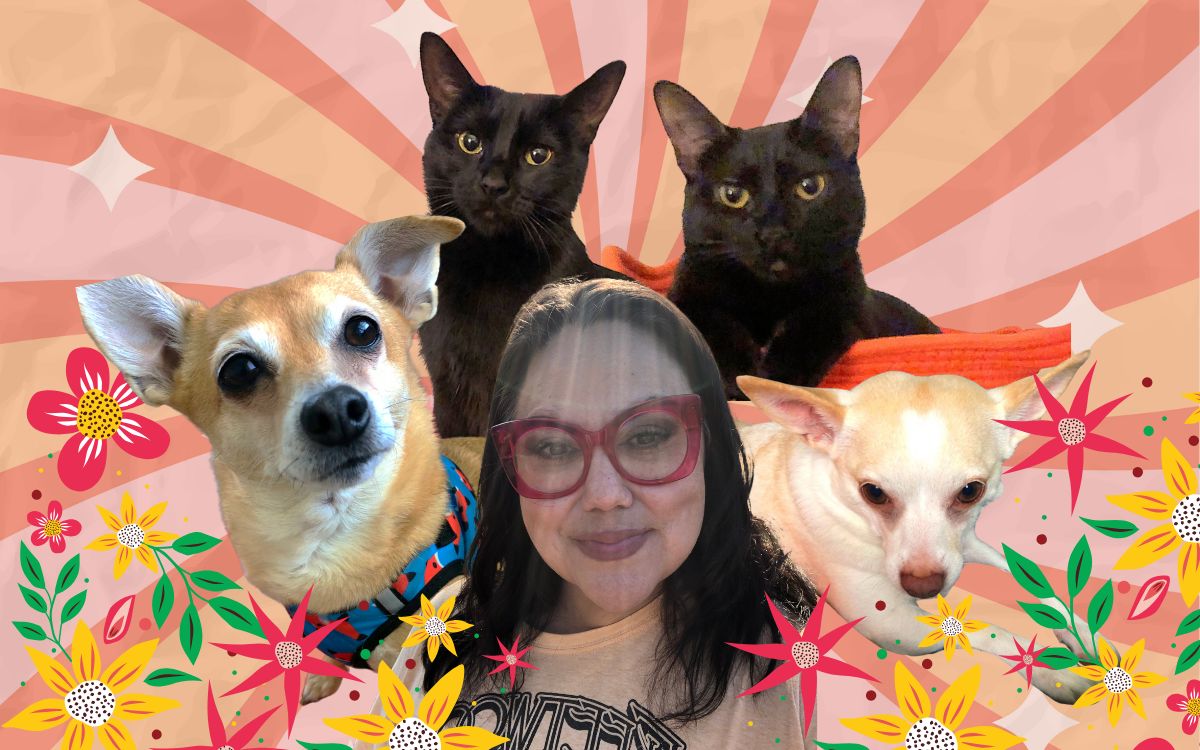
Melissa Lopez, 46, was at home with ‘the coven’ – her two dogs Foxy and HoneyBee, and her two cats Stevie Nicks and Dulce – when she got a notification from Southern California Edison saying there might be a possible power shut-off in her area on the morning of Jan. 7.
Lopez lived right off of Lake Ave., in Altadena – a city that sits at the bottom of the Eaton Saddle near Mount Markham and San Gabriel Peak in the San Gabriel Mountains, part of the Angeles National Forest.
The fire stretched across 14,000 acres over the weeks it took to contain it. The latest report released on Jan. 27 by the LA County Fire Dept., listed 17 civilian fatalities, nine firefighter injuries and thousands of threatened, damaged and destroyed structures as casualties of this fire.
Lopez’s was one of the structures that was destroyed shortly after Lopez and her four pets evacuated.
She recalls that she was watching the news about the Pacific Palisades fire when the reporter got notice that there was a fire starting up in Eaton Canyon, announcing it live on the news. At that moment Lopez felt her stomach drop.
“The second I heard that, my stomach just dropped, because when you live in Altadena, you kind of get notices of brush fires all the time. But, I knew this time was different because of the intensity of the wind,” recalls Lopez.
Lopez, whose pronouns are she/they, is a licensed clinical social worker and mental health therapist who works primarily with queer clients in the Los Angeles area. They also have over 100 thousand followers on Instagram as @counseling4allseasons, where they regularly post and repost memes and educational material that is relatable, relevant and helpful for queer, trans, BIPOC, disabled and otherwise marginalized people. Lopez is known as a community leader who has been actively outspoken about issues that are intersectional with race, genocide, immigration, capitalism, patriarchy, queerness and mental healthcare.
At the time of the interview, Lopez was having a particularly hard day as it was the one month mark since the start of the fires that burned through Altadena neighborhoods.
“Today is a hard day. It’s the one month anniversary of when I evacuated Altadena,” said Lopez in an interview with LA Blade. “I feel really pissed today. I’m pissed that so many things happened that could have been prevented.
Lopez recalls that on Tuesday Jan. 7 when the Santa Ana winds were blowing the strongest, she received the notification about the power possibly being shut off, but during the time leading up to her evacuation, she recalls that the power was never shut off. All the other alerts she received came after the fire had already started.
As she was preparing to evacuate, she says that she was in communication with many of her friends and nearby neighbors.
“It was really confusing because I was texting a couple of people and some were saying they hadn’t received [a notification], while others had,” said Lopez.
At that point, their own instinct and intuition led them to make the ultimate decision to begin evacuating.
“Everything’s kind of a blur, but I started to just grab the dogs and cats,” they said. “So I started getting all of their supplies like their food, litter – everything they use.”
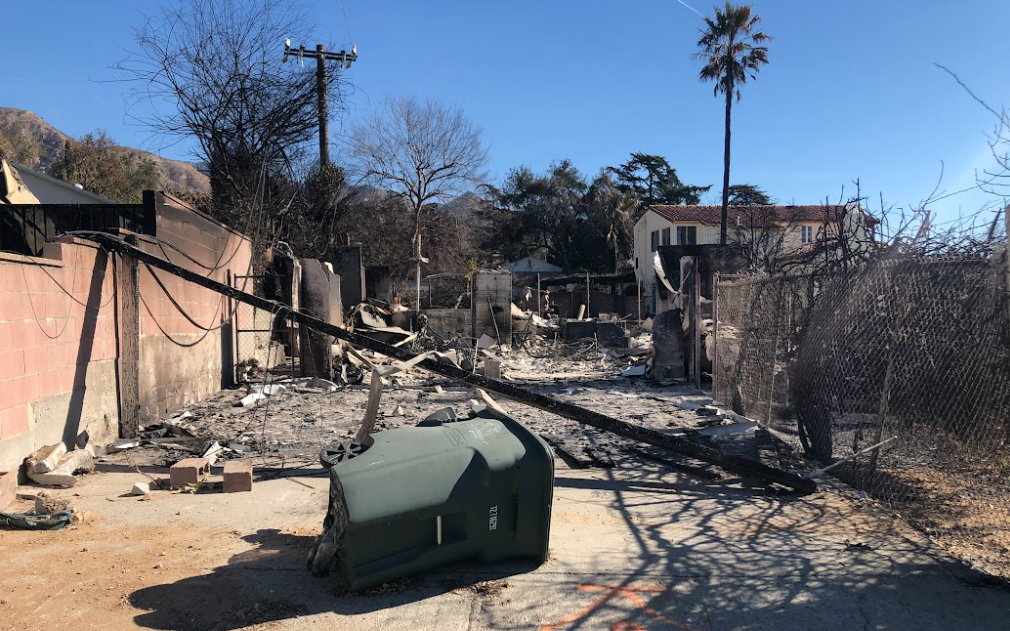
The aftermath of the fire on the property that Lopez rented a back house in (Photo courtesy of Melissa Lopez).
As soon as she was able to find short-term housing through AirBnB, she began organizing a group now led by a colleague of Lopez, to help people who had been directly affected and displaced by the Eaton Canyon fire. In the group, they discussed the experience of making the decision to take the evacuations seriously and begin gathering their belongings. She says she even felt ‘silly’ at some point, because she believed she would just be able to return the following day.
“What I tell people now is that I don’t care how silly you feel. I don’t care if you pack up half your house and feel silly about it. If your house ends up burning down, you will be so grateful for it because there are so many things I wish I would have taken.
Though Lopez says they don’t remember an exact timeline, they remember seeing the fire move in really fast and by the time she began evacuating it was complete chaos out on the main streets of Pasadena and Altadena because of the hundreds of people evacuating.
“Some of us had gotten notices, some of us warnings, some of us hadn’t,” Lopez recalls the confusing ordeal.
The smoke began to cloud the area so Lopez put her dogs into her car, but struggled to get her cats into a carrier and one of them was almost too scared to grab. She was able to make it out of the danger zone with all four of the members of ‘the coven,’ as she likes to call them.
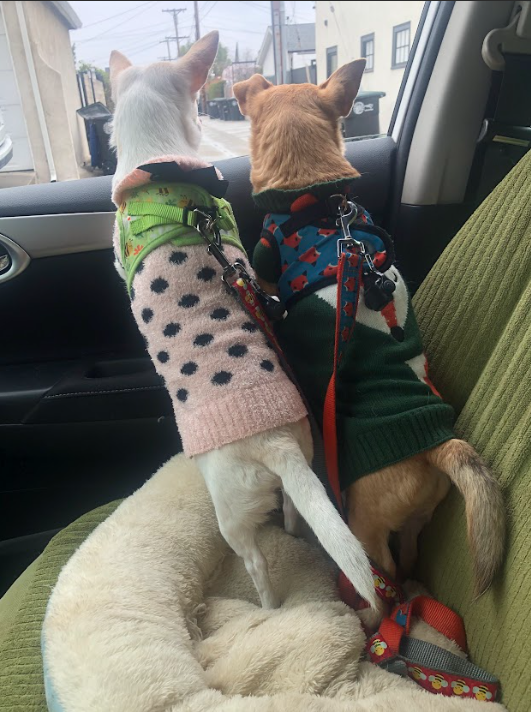
Lopez gathered her coven and evacuated, saying goodbye to many of her belongings (Photo courtesy of Melissa Lopez).
“I had a friend who was going to take us in who lives in San Marino and driving there is basically a straight shot, but because it was so windy, some trees had fallen over and some of the [street] lights were out, so it was all really chaotic.”
Lopez believes that the community support she has received since the evacuations has gotten through the hardest parts of the experience. Mutual aid came to Lopez’s rescue during this difficult time. Navigating the resources and legal assistance was incredibly difficult because of the stress, trauma and grief she is still currently experiencing.
The Eaton Canyon fire burned through a large part of Altadena, an area that is predominantly and historically Black, Latinx and working-class.
“I think it’s important for folks to remember that showing up for community is actually very political,” said Lopez. “I want to encourage people to show up and even if you don’t know people, show up. Even if you don’t f*cking like people, show up.”
Lopez says they are very grateful for the community that showed up for them and that it is not only important to show up for this current disaster, but for everything marginalized communities are currently facing. They received many messages on IG from people offering their support in a variety of ways and that was all impactful to Lopez. They say that a lot of the support they received was from people they directly and personally knew, but a lot of it also came from people who were complete strangers.
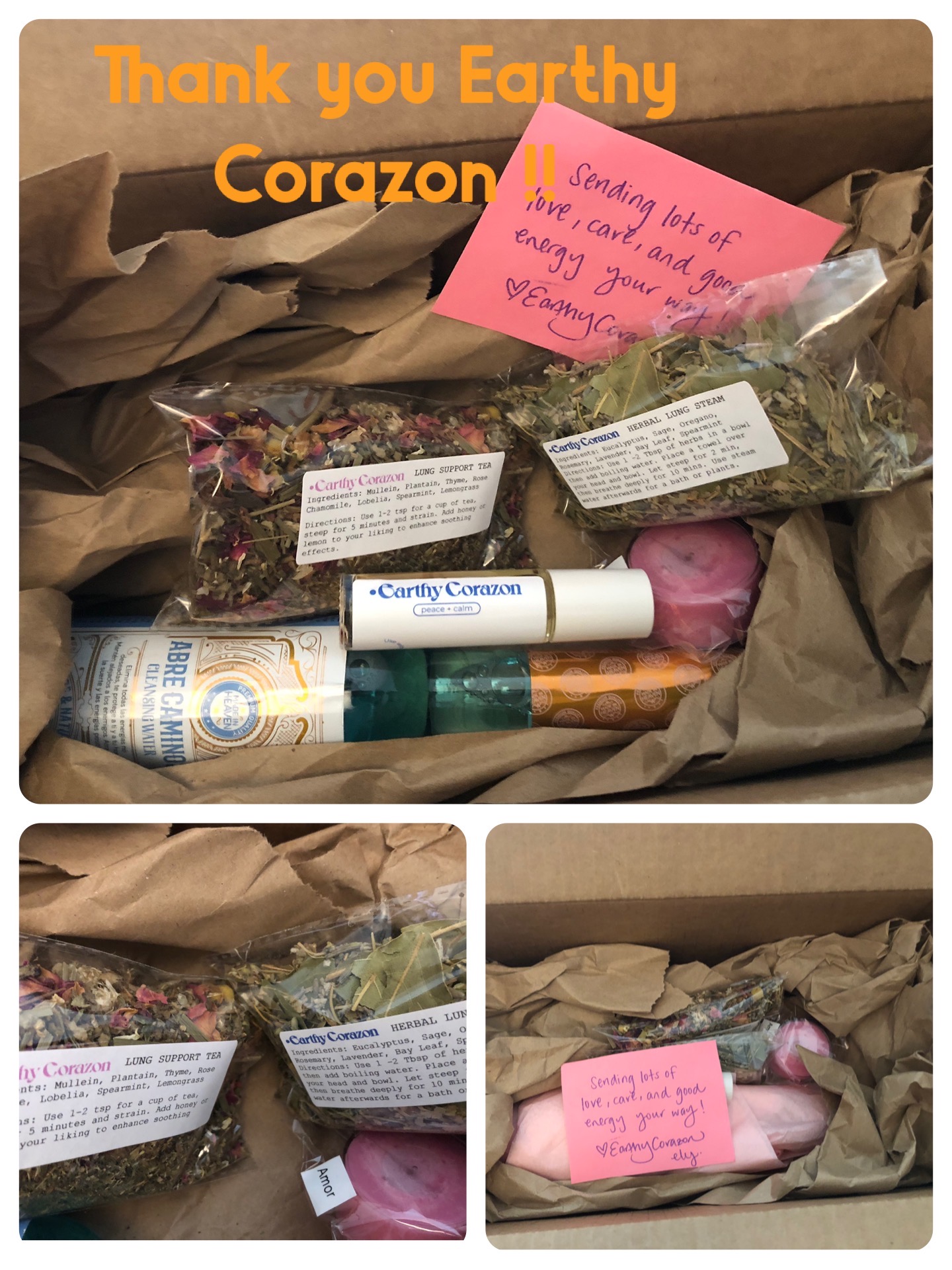
Lopez received holistic healing care packages from businesses like Earthy Corazón (Photo courtesy of Melissa Lopez).
In Lopez’s case, she was able to get her monthly rent for January and security deposit returned. She says she realizes that this is not the case for most people who are also navigating the aftermath of this disaster.
“I do want to highlight that I think tenants are having a really hard time because a lot of the resources and a lot of the support goes to homeowners and that is obviously a huge class issue,” said Lopez. “One thing I tell people now is get the f*cking renters insurance.”
The cause of the fire that took weeks to fully contain is still under investigation and many renters and homeowners await answers from insurance companies on their long path toward justice and permanent housing.
Features
Out at the Fair Kicks Off Pride Season In SoCal
OATF continues to forge ahead with queer representation at local county fairs
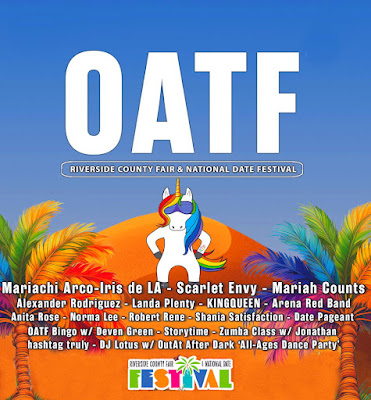
Though the LGBTQ+ community is under attack day after day, queer organizations are not giving up the fight and instead are choosing to forge ahead with an even louder voice. Out At The Fair (OATF), is kicking off LGBTQ+ event season with a bang this week. Since it began in 2011, Out at the Fair has become the official LGBTQ+ event of the fair industry.
This year’s season starts at the Riverside County Fair & National Date Festival on Saturday, February 15th at 11 am. The Glam Show will feature a performance from Drag Race alum Scarlet Envy, who also appeared in the franchise’s All Stars and UK vs the World iterations. In addition to a number of California dates, OATF will appear in New Mexico, Oregon, and Alaska.
Simply put, it is a day the queer community gathers and takes over stages at your local country fair. This year Out At The Fair will appear in 13 cities in four states. The organization provides visibility for the LGBTQ+ community and creates an inclusive day at the fair with main stage music performances, drag queen story time for youth, community resources, health resources, giveaways, family-friendly activities, and a grand finale Glam Show featuring drag performances.
In this LA Blade exclusive, we chatted with Out At The Fair CEO and Founder William Zakrashek. Coming from a nightlife and DJ background, Will and his partners have kept OATF going strong, despite political and queer-phobic setbacks. The production team that travels on the road to each of the Fairs has been pretty much the same from its inception, a testament to the mission and professionalism of the organization.
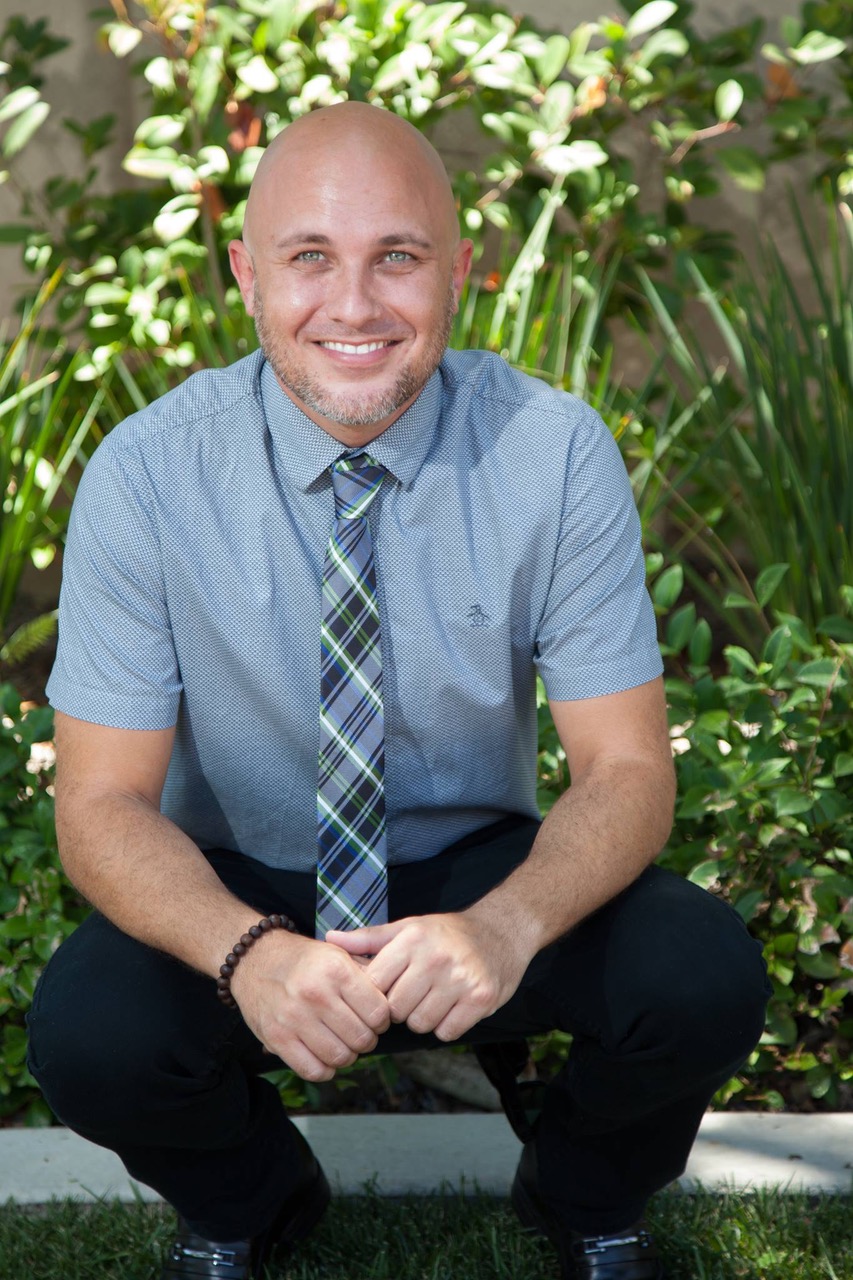
OATF Founder William Zakrashek (Photo courtesy of OATF)
What was the inspiration to start Out at the Fair?
In 2011 we went to the San Diego County Fair and noticed there was no representation of the LGBTQ+ community so we just checked in on social media calling it the “Unofficial Gay Day.” Honestly, we didn’t think anything would come from it until the following year I got a message on social media asking if we were doing the gay day at the Fair again. We made an official Facebook event that year calling it the “Unofficial Gay Days” and were invited by Luis from Marketing at the SD Fair. They welcomed our full group to the fair, gave us pins, and took our photo. The following year I was invited to official SD Fair planning meetings and the vision of Out At The Fair came together and the rest is gay history now.
What have been your biggest challenges in producing these events?
Out at the Fair has to transform a conservative industry while changing the perception of the county fairs to our community. Because of the family-friendly nature and conservative backgrounds of Fairs, the queer community hasn’t felt like they can be themselves. I have to say with years of work, it is now. Every location with an OATF not only showcases our community to the full Fair but now welcomes the community to events at the Fair, 365 days a year. We hear from our Fair partners that the uptick in our community coming to the grounds beyond just county fair time had a huge increase.
Have you had any pushback from the straight, conservative community with OATF’s presence?
We have had the normal pushback that Prides get with protestors outside of the gates or rude verbiage from someone walking by our booth, but it has never been anything where we have felt threatened. We have a rule at the booth, if someone is video recording you and you do not feel comfortable, video record them back so we can handle it with the Fair teams. We work so closely with locations to make sure every year we get better and better at creating that safe space.
But sometimes, that pushback comes from inside the Fair industry from production crews that do not have the same values as OATF. They limit their responses, limit the info we get to pass on to our partners and come up with any way possible to make it harder for us. The problem with their plans is that our Fair partners know about these struggles so it will only hurt their own relationships in the end.
What have been some of the biggest achievements of Out at the Fair?
Out At The Fair won the highest business award from the Fair industry called the Barham Award in recognition of our reliability and excellence in what we do. But the awards aren’t the real achievements we have made when it comes to progress for our community. We have created the first LGBTQ+ safe spaces in some of Fairs’ histories (some over 100 years!), producing stages, bringing drag to the fairs, and building out a foundation for a real connection. This summer we will be doing our furthest north Glam Show 160 miles south of the Arctic Circle in Fairbanks, AK! It’s pretty incredible the opportunities we can open up to our talented community that wasn’t there before.
You travel with your crew from city to city, what are the realities of life on the road?
Where do I even start? You better love your business partners and understand that the privilege of privacy during Fair season isn’t a thing. I have to say, don’t eat a Subway at a gas station because we have seen food out at 2 AM while taking a pee break. Tuna fish needs a fridge. We have to haul a trailer with us from location to location for all the setups, so between sleeping in the truck on the side of the freeway with our two dogs or hitting an elk in the middle of Arizona at midnight on our way to New Mexico, the event must go on. Even when the state trooper is telling us to stay at a hotel, we had to push on with part of the front end missing on the truck and elk fur all over it. Albuquerque or Bust!
I think the craziest thing I have seen was after driving back from Oregon last summer when we took the Nevada way because the 5 Freeway is no fun with a trailer. But there was a massive fire north of Sacramento and it took us six hours to drive through the smoke while it rained ash on us. We really get to see all parts of this country while driving through it.
What do attendees walk away most with?
A real sense of humanity. Life has just been so crazy in the past years and seems to be staying on that trend. The love and feeling of acceptance that happens during an OATF day is hard to describe. When you see people who obviously had no idea it was the LGBTQ+ stage area but sat down, started watching talent, and never left, is a great thing. It’s really cool to be able to showcase our community to people who wouldn’t go to a Pride since the Fair is such a mix of the general public.
In addition to scheduling well-known national performers, you work with the city’s local queer talent. What have you learned from working with entertainers out of town, how does their queer experience differ from Southern California’s?
This is my favorite part of doing this type of event. We really do try to create programming that fits each area we serve. Drag is just as different in New Mexico as the mix of music you would expect on the stage from our festival at the San Diego County Fair. There is some amazing talent in rural areas that need to be showcased more and I am so proud we are able to give those chances. From artists in New Mexico, Oregon, California, and Alaska, the one thing they all have in common is the appreciation of being given a platform none of them thought was possible.
OATF kicks off this season at Riverside County Fair, what can audiences expect?
This OATF is always the first Pride day of the year in California and 2025 is our 3rd Annual Celebration in Indio, California, and will be our biggest yet! We are thrilled to have RuPaul’s Drag Race superstar Scarlet Envy headline our Glam Show, Drag Race guest-judge Deven Green host our OATF Bingo, and a full day of family-friendly entertainment on the Pageant Stage. You can even catch the first LGBTQ+ Mariachi group perform & grab the full family for Out At After Dark w/ DJ Lotus for our all-ages dance party. For the first time, there will be an ‘All-Inclusive’ bar on site presented by KGay Radio and we will have some amazing local queens to mingle with. Make sure you stop by the Out at the Fair® booth because Butler Amusements is partnering with us and the first 150 people will get a ticket for a free Ferris Wheel ride. We really do try to build programming for everyone & showcase the community. Check out everything going on our website today.
How will 2025’s Out at the Fair be different than past years?
There are some locations in rural America that aren’t ready for drag shows and queer artists BUT that doesn’t mean their fair doesn’t support what we do & our community. So, for the first time in 2025, we will have Safe Space locations. We want to build a space that is safe for the LGBTQ+ community in areas where it was never possible.
Why is it so important to have a queer presence at Fairs?
It is so important because there is a fair in everyone’s backyards and those were made to showcase the community they serve. Our community lives in every neighborhood, town, and rural corner of this country and they all deserve to be celebrated. There are also queer people inside the Fair industry who have never been able to perform as out performers. We have had a few bands tell us that until we were around and helping change the perception of the LGBTQ+ community, they had never performed before as themselves. From 4H kids to vendors, and office workers, there are literally queer people everywhere and it is an honor to make them finally feel welcome in an industry that never really embraced us.
An example of this was in Oregon, where we met a trans community member who had transitioned between the Fair season but wasn’t going to come back to work until they realized OATF was now at their Fair. Even the guests who don’t have a supportive family at home feel that the Fair is the only place they can be themselves. In Sonoma County, we had a few youths stop by our booth, and grab rainbow flags, but put them quickly into their bags. We asked them why. They told us that their family doesn’t approve of them wouldn’t approve of them being there and thanked us for having a welcome space. They quickly turned around and ran away down the midway.
How are the political changes toward the LGBTQ community going to affect Out at the Fair?
For now, we are seeing the people who didn’t align with our ideals be more vocal. We have also experienced an unfortunate downtick in sponsorships. We will keep pushing through! No matter what the ‘rules’ these new political times bring, Out At The Fair will always be a safe place for the full LGBTQ+ community. We also have been working closer than ever with our Fair partners to ensure the safety of these spaces. An example is Riverside County Fair will have the Riverside County Sheriff on site, Indio PD on the perimeter, their own private security, and Fire & Medical onsite. If you see something, say something so we can keep every public event safe this summer for everyone.
How can our community support the efforts of Out at the Fair?
Come to an Out At The Fair this year, we would love the in-person support and your presence speaks volumes nowadays. But if you can’t make it to one of our 13 locations in 4 states, we do have merchandise available online starting at $7 and 100% of these proceeds go to the OATF tour. It helps us to give the smaller Fairs the same production & attention as our largest Fairs. Visit www.OutattheFair.com to learn more about what we do & shop our merchandise line.
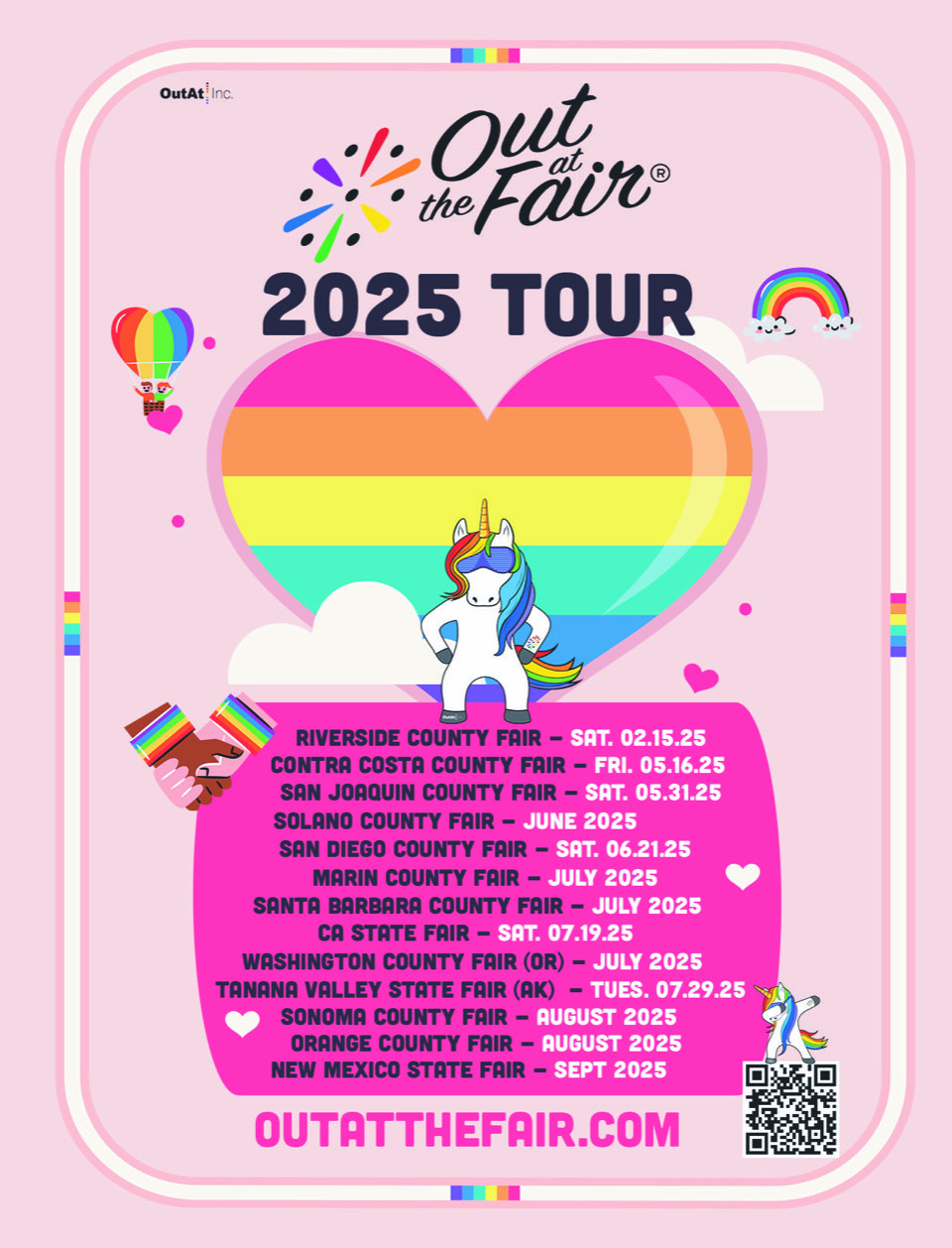
OATF Tour 2025 flyer (Photo courtesy of OATF)
a&e features
An invite-only LGBTQ+ app surged in popularity after Trump’s executive orders
Famm Connect provides a safe haven for job seekers and community support amid LGBTQ+ attacks
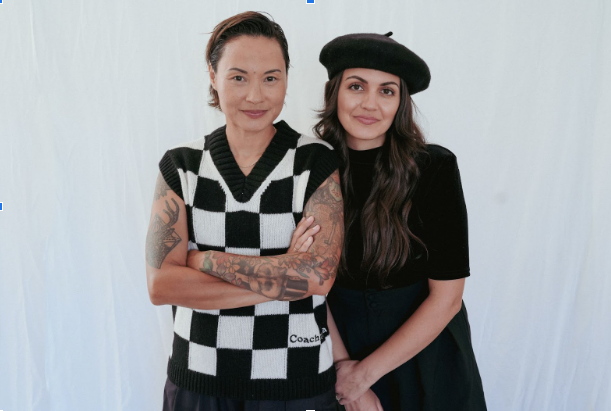
President Donald Trump’s latest executive order, restricting transgender individuals from serving openly in the military, has sparked a surge in activity on Famm Connect, a new professional networking app designed for the LGBTQ+ community.
The Secretary of Defense, Pete Hegseth, has a 30-day deadline for submitting a plan to execute the order. Until then, many have been turning to the invite-only platform, created in Dec. 2024, to find support, resources and career connections in the face of increasing change.
Its California-based co-founders and married couple, Marianna Di Regolo and Cat Perez, said their app has grown more than 70% within the last weeks. Di Regolo noted that the app provides a safe digital space for members fleeing those opposing their community.
“Famm Connect is our response to Trump and really anyone else who creates barriers for or discriminates against LGBTQ+ folks. So with Trump signing executive orders against our community and major organizations cutting DE&I programs and platforms like Meta removing protections for LGBTQ folks, spaces like Fam Connect are more important than ever,” Di Regolo told the Los Angeles Blade.
The LGBTQ+ community, according to Di Regolo, feels unprotected on other professional apps where hateful comments aren’t filtered, so her app serves as a haven for those looking for new jobs.
“Just in general, as a lot of us have seen, quite a few LGBTQ+ folks don’t feel safe on a lot of the other platforms, and they might be growing in their career or looking for a job or just looking to connect with other folks professionally,” she said, adding: “They’re on our platform letting folks know, ‘Hey, I’m looking for X, Y, and Z job,’… and they feel safer and more comfortable doing it in a secure space.”
As attacks on LGBTQ+ rights intensify—from political figures rolling back protections, advocates are doubling down on support for their communities, according to a spokesperson at GLAAD, a non-profit committed to LGBTQ+ advocacy and cultural change.
“Now more than ever, LGBTQ+ people are stepping up to take care of and support each other and our families. No matter what rhetoric is spewed [by] government officials or anti-LGBTQ+ extremists, our community and allies will persevere. Building community, finding and giving support, and making connections in spaces where we all can feel safe will be a critical part of surviving and thriving, no matter what we are up against.”
Trump said in his latest executive order against Trans troops that “For the sake of our Nation and the patriotic Americans who volunteer to serve it, military service must be reserved for those mentally and physically fit for duty.” This message didn’t resonate with Perez, who said Trump’s executive order is fear-mongering, among other things.
“It’s absolutely ridiculous. There’s no basis [on] which that decision was made. It is absolutely transphobia and a fear tactic that they are using and a general strategic tactic that Trump and his administration are using to distract the American people from real issues that they should be focused on for this country,” she said.
Perez also argues that his stance not only dehumanizes trans people but also ignores the reality that: “Trans people are humans. They’re human beings. “They’re absolutely capable of serving in the military, and they have, and it’s just disgusting that that is the message that he is putting out there.”
JaRel Clay, the vice president of the Board of Directors at SpeakOut, a non-profit that aims to create safe spaces across LGBTQ+ communities of color, says Famm Connect is a critical employment resource for “the trans community in the midst of attacks coming from the Trump administration.”
“We know that there is power in community, and especially for this community facing heightened risks, both in their areas and federally. An app like Famm Connect is more than a tool. It’s a lifeline,” Clay added.
Clay asserts that Trump’s rhetoric regarding the lack of mental fitness of trans-serving troops is “woefully uninformed.”
“How do you suggest that their military readiness and public service are at a disadvantage simply because they are trans? It’s, again, just woefully uninformed and ignorant,” Clay said. “It’s un-American. It is the fabric of our being that we address and assess the readiness of any individual who wants to serve our country based on the merit of how they perform.”
Perez said that she sees the LGBTQ+ community coming together and showing up for one another on the app since other platforms have censored terms like “lesbian” or other words about their community.
The Human Rights Campaign claims that Meta’s new social media policies “endanger LGBTQ+ communities.” Perez says censoring their communities is incredibly problematic, so they are building up Famm Connect.
“I think for folks who are struggling right now in the community, within their careers, I think seeking out the queer community and seeking out safe and intentional spaces and really making those connections is going to be the thing that helps get you through these turbulent times,” she noted.
Contributing writer, Eden Harris is a D.C. native with a passion for uplifting marginalized voices on a global, national and local level. She has experience covering the White House, Capitol Hill, the Supreme Court and federal agencies. She covers mainly all things Africa and is committed to doing so with the highest standards that drive true equity for the continent and its U.S. diaspora.
Events
Botitas World: the business brand aimed at building community
Cafécito and Comunidad, the event to gather in QTBIPOC community

Zizi Bandera and Ty Curiel, came together to form what is now Botitas–a small business brand and organizing space for Queer, Trans, Black, Indigenous and People of Color to celebrate and embrace identity, ethnicity and community.
The co-founders of Saturday’s Botitas event Cafécito and Comunidad, say they had to close the RSVP’s because they reached capacity and were afraid of having issues with the Parks and Recreation Department that issues parking permits and sets a limit for the number of people allowed to gather at Elysian Park in Los Angeles.
“It’s our first event here and it’s an amazing turnout,” said Bandera. “TikTok blew us up.”
Bandera referenced the TikTok video they posted announcing the event and says that they woke up the next morning to see that they had well over a hundred RSVP’s for the event that they expected would only have a couple dozen people.
“We had someone who is part of our community call up the councilmember for this district and was able to talk to whoever is in charge of Parks and Rec to OK more capacity,” said Bandera. “[Eunisses Hernandez, Councilmember CD-1] also got us the tables and permits.”
Bandera stresses that the amount of people who reserved a spot for the event comes to show the need for space like Botitas.
“I thought it was going to be maybe fifteen, twenty people,” said Bandera.
The space is held intentionally for the BIPOC community within the broader LGBTQ+ community, with the intention of centering BIPOC voices that can otherwise be erased, marginalized, sidelined or silenced in broader community conversations.
“Our focus is to have these community spaces and to serve our trans Latine community in Los Angeles and beyond,” continued Bandera. “We thought about making this project a nonprofit, but we wanted to really have full agency and control over, in terms of the needs of our community.”
Bandera says that going the nonprofit route has its own challenges and obstacles because of different stakeholders. They stress the importance of their community being the stakeholders in this business journey.

Though the day was a bit gloomy with some light rain, many people gathered to mingle, chat and yap, along with some coffee at Elysian Park in Los Angeles this past Saturday (Photo Credit Gisselle Palomera).
“I’ve been working in community organizing, mobilizing around LGBTQ and immigrant issues for almost fifteen years now and I’ve always wanted to create something that was for us, led by us–queer, trans, Latine and intergenerational.”
Bandera says that they were inspired to create this space for QTBIPOC because of a report released earlier this year pointing to a loneliness epidemic that disproportionately affects LGBTQ+ people over their heterosexual peers.
The report states that ”…LGBTQ+ youth exhibit higher rates of loneliness, social isolation, and depressive symptoms than their heterosexual peers. Moreover, LGBTQ+ youth grappling with loneliness are less likely to reach out for help regarding their mental health concerns.’
The other co-founder of Botitas has different reasons to have started this business journey.
“Botitas is one day today and another thing tomorrow,” Curiel said. “Our idea came from wanting to create a brand–something that you can wear when you’re out and about in the city. A brand that is backed by people who resonate with you as Latine folks, queer, trans and that’s what we are.”
Curiel also states that the current state of politics also plays a major role in his idea to create Botitas. “We want to [create these spaces], especially in this time and age where there’s a rhetoric of people spreading hate.”
This event is in a public space, encouraging people who show up, to gather in a space that supports sobriety. The offerings included cafécito, pastries and games.
Earlier this year during pride month, Curiel says he and Bandera were looking at historic news articles and photographs of LGBTQ+ life in Los Angeles during the 1950s and 60s, from an exhibit at the Central Library in DTLA, and that’s when it hit them both that none of the people in the photos looked like them. They did not feel represented.
This moment urged them to reconsider what it means to them to feel represented, heard and seen–thus bringing about the idea for Botitas.
Follow @Botitas.World on Instagram and TikTok to get more information on upcoming events.
Arts & Entertainment
Meet the whimsical, fairy-core Uber driver who drives a car named Mollie
Nonbinary Uber driver, Caspian Larkins is rolling on Mollie– no, not that one

Forest green faux fur, rhinestones, a fabric-lined ceiling, planted faux flowers and green plastic grass adorn the inside of an anthropomorphized car named Mollie who spends her days riding off into the sunset on Sunset Blvd in West Hollywood and beyond.
The driver of this 2008 Ford Escape, Caspian Larkins, 24 and a Cancer sign, moved to Los Angeles to pursue acting and through a series of humbling restaurant jobs and other side hustles, ended up driving for Uber. Though working for Uber was not on Larkins’ bingo card for 2021, they wanted to find a way to make the experience not only fun for themself, but also for the people who roll on Mollie.
Larkins, who identifies as nonbinary and queer, grew up being one with nature in the wilderness of Oregon and when you step inside Mollie, it feels like a little magical, mystical slice of Oregonian forest–of course if it were reimagined on four wheels and zooming through traffic in Los Angeles.

Forest green faux fur and a pink ruffle with a layer of tiny fabric roses, line the doors. Stickers on the sunroof and windows reflect rainbow hues across the white leather seats and passengers. (Photo credit Gisselle Palomera)
Going viral overnight doesn’t happen to just anyone, but this iconic duo now have thousands of followers on social media and have big plans for the future.
ShaVonne Boggs, a content creator who hailed an Uber ride from Larkins, posted an Instagram reel of the ride and featured Larkins in all their fairy-core glory, driving through L.A traffic, with the viral Gwen Stefani ‘Just a Girl,’ audio clip playing over.
“I went to bed that night with a couple hundred followers on my account and I woke up the next day and I had gained like 3,000 followers,” said Larkins.
Larkins has a unique sense of style that incorporates nature, fashion and sustainability, often foraging for materials from the side of the road to add to the car and accepting donated fabrics from people who reach out to them through social media.
“I’m a forager. What can I say?,” said Larkins and then jokingly added that Jeff Bezos also personally delivers some of the items they use to decorate Mollie.
“I come across stuff on the street sometimes that I’ll pick up, put in my car and repurpose.”
Larkins says that Mollie is a little bit dinged up and bruised up from the outside, but that it’s the inside that truly matters.
There is a third character in this story that resides on the inside of the car at all times.
Jack Aranda is the name of the guardian angel of this fairytale ride. It is a miniature rubber ducky that was given to Larkins by a spiritual witch that opted for an Uber drive, over a broom one night.
“It was midnight, by Venice Beach and you know it was good vibes, but yea she gets in and we’re talking and she’s like ‘I’m going to give you this duck,’ and gives me this little tiny purple good luck duck,” said Larkins. “So I kept the good luck duck and I put him on my dashboard.”
Larkins says that ever since this encounter, the luck in their car changed.
“Red lights will always turn green for me, and sometimes someone will run a red light and miss [hitting] me and I just think it’s divine intervention because of Jack.”

Larkins poses in front of their car Mollie on a road in West Hollywood, CA. (Photo Credit Gisselle Palomera)
Larkins says that the decorated interior and its elements serves not only as a conversation starter, but also as a filter from unwanted conversations and painfully boring small talk.
“I think that since I’ve decorated my car, it’s like my filter,” said Larkins. “The people who get in and are like, ‘Oh my god,’ those are my people and those are the ones that I’m there for. And the ones that get in and are silent, I just let them sit there and soak in the rainbows.”
They say that there have been more good interactions, than bad ones and more people who ‘get it,’ than those who don’t.
Anthropomorphizing cars is nothing new to pop culture. In fact, cars have almost always had names and it is almost a part of engrained American culture to assign personalities to them based on their cosmetic characteristics.
The earliest examples on TV go as far back as the 1940s and some of the most memorable examples are Christine, the possessed, killer Camaro from Stephen King’s imaginative mind.
Or Herbie, the 1963 Volkswagen Racing Beetle from the early cartoon TV show Herbie, the Love Bug.
In everyday routine, people spend so much time and energy on and around inanimate objects, that they sort of become meaningful elements who accompany us on our journeys from here to there–and back.
“What I’m doing now with her is switching out different designs with the seasons,” said Larkins.

Larkins drives around Los Angeles and West Hollywood, picking up and dropping off people from all walks of life. (Photo Credit Gisselle Palomera)
“So right now we have our spring/summer look and a lot of the things in there are removable, velcroed and stapled.”
They say that right now they are exploring a very niche area of automotive interior design that they feel has not been explored within vehicles recently.
“It’s just hard for other people to conceptualize it and what I often describe to people, comes off as very tacky and just kind of nasty– not demure, not cute.”
Larkins feel they are really just now setting the stage for what’s possible, as far as interior customizations.
“I want to start creating this world in which design plays a bigger role in what a car could be and the experience of just being transported,” said Larkins candidly. “I want to invite people into my little delusional fantasies.”
Larkins believes that even in the present and near future of self-driving vehicles, they would like to collaborate with these major self-driving car companies and take part in designing and customizing the vehicles so that it can be a pleasurable and fun experience for riders who might feel anxiety about self-driving technology.

The inside of Mollie is adorned from top to bottom and from left to right. (Photo Credit Gisselle Palomera)
Modifying and customizing cars has been a part of the North American experience since the early 1930s. Now, attention is shifting toward the addition of technologies like Augmented Reality, to enhance the experience of driving and getting from point A to point B, and also using that technology to navigate the vehicle without a driver.
There are now endless possibilities when it comes to custom car culture and Larkins feels this is their place to explore and forage for the looks that people want and can’t even imagine.
“I want to step away from driving for the platforms and I would love to design with them,” said Larkins. “There is a group of people that are in support of this future technology and there is this other group of people that are kind of scared of it because it feels very cold and very uninviting and very new, so I would like to be the one to sort of bridge that gap for those people and make it less scary.”
The vision that Larkins has, is that they would like to reimagine the possibilities of custom interiors with interchangeable parts and additions that one could only think of as synonymous to Barbie and her endlessly fun assortment of interchangeable outfit components.
Larkins sees a long future ahead, where they have the opportunity to collaborate with airlines, rideshare companies and any other sponsors who are willing to make their visions come to reality. Until then, they will continue to weave up and down the asphalt arteries of WeHo and beyond, rolling on Mollie and working on their fairytale ending.
-
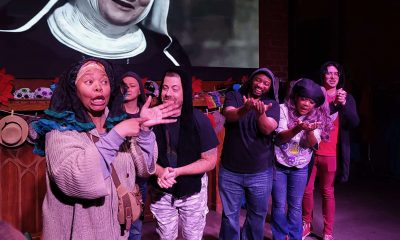
 a&e features3 days ago
a&e features3 days agoMusical Mondays, a mainstay in WeHo nightlife, celebrates 16 years
-

 National2 days ago
National2 days agoDiscredited former cop played ‘key role’ in deportation of gay make-up artist
-
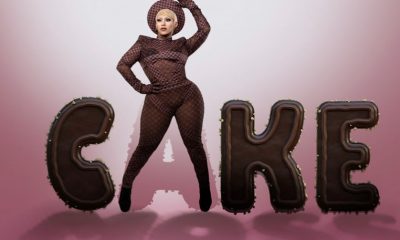
 Arts & Entertainment3 days ago
Arts & Entertainment3 days ago‘Bring it to Brunch’ returns to West Hollywood
-
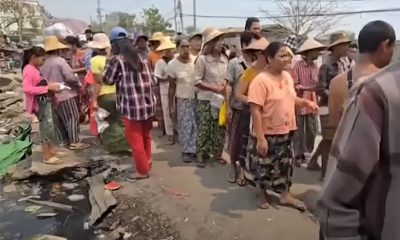
 Myanmar3 days ago
Myanmar3 days agoLGBTQ+ advocacy group joins Myanmar earthquake relief effort
-
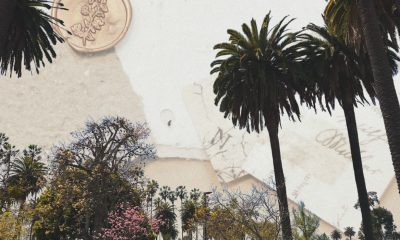
 California2 days ago
California2 days agoSouth Park provides green space to a predominantly Latino community
-
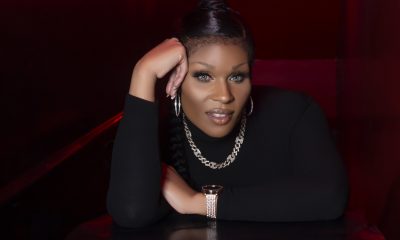
 a&e features3 days ago
a&e features3 days agoPeppermint thrives in the spotlight
-
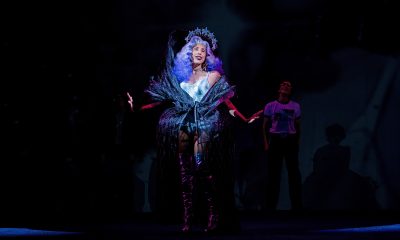
 Arts & Entertainment17 hours ago
Arts & Entertainment17 hours agoSouth Coast Repertory Theatre hosting world premiere production
-
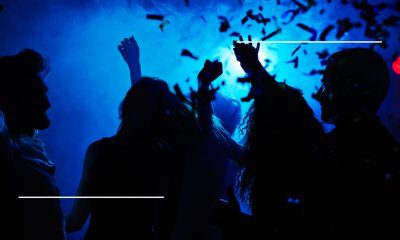
 Arts & Entertainment12 hours ago
Arts & Entertainment12 hours agoA Night of Legacy, Love, and Liberation: Inside the 2025 April Fool’s Ball
-
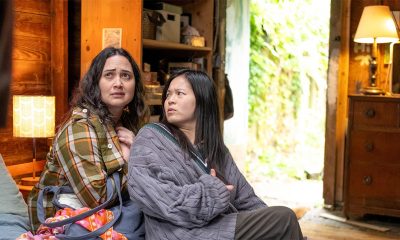
 Movies2 hours ago
Movies2 hours agoHeartfelt ‘Wedding Banquet’ remake a romcom worth seeing
